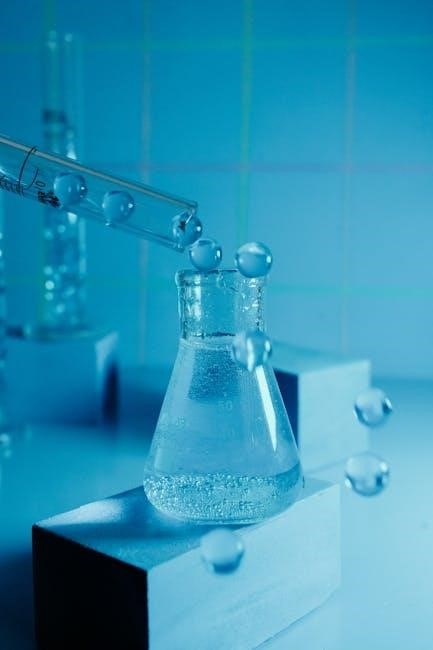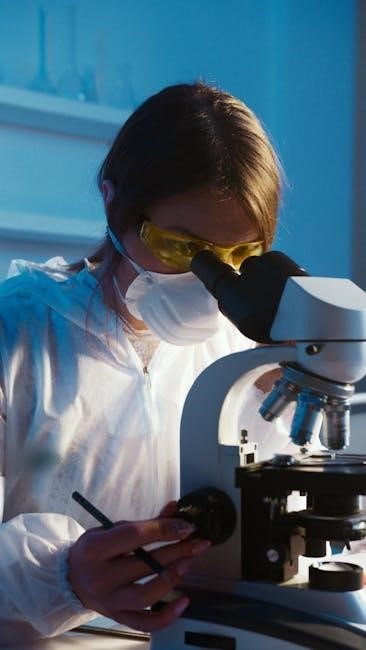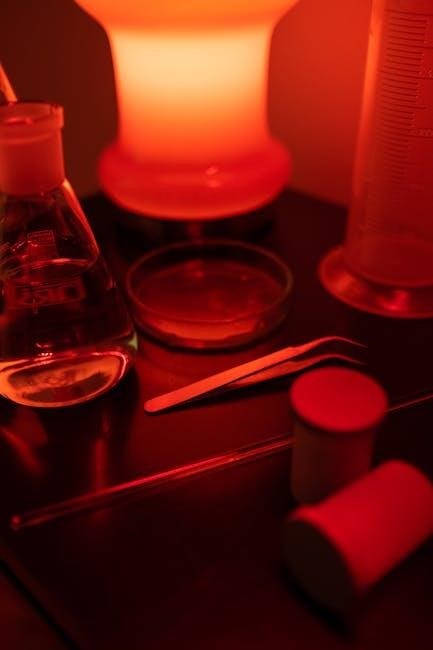
general chemistry laboratory manual
This manual serves as a comprehensive guide for students, providing essential laboratory techniques, safety protocols, and experimental procedures in general chemistry․ It ensures a structured approach to hands-on learning, fostering practical skills and scientific inquiry․
Overview of the Manual’s Purpose and Structure
This manual is designed to guide students through general chemistry lab experiments, emphasizing safety, precision, and scientific methodology․ It is structured into sections covering essential techniques, safety protocols, and common experiments․ Each chapter focuses on specific skills, such as measurement, titration, and data analysis, providing clear instructions and theoretical background․ The manual also includes digital tools and resources to enhance learning․ Its organized format ensures students can navigate easily, mastering both fundamental concepts and practical applications in a structured and safe laboratory environment․
Importance of Laboratory Work in General Chemistry
Laboratory work is crucial in general chemistry as it bridges theoretical knowledge with practical application․ Through experiments, students develop critical thinking, problem-solving skills, and hands-on experience with scientific tools․ Labs foster teamwork, data analysis, and communication of results, preparing students for real-world challenges․ They also enhance understanding of chemical principles, making abstract concepts tangible․ Engaging in lab activities ensures students gain a deeper appreciation for scientific methodology and safety protocols, essential for future careers in STEM fields․
Safety Guidelines and Laboratory Rules
This section outlines essential safety guidelines and rules for conducting experiments in a general chemistry lab, emphasizing personal protective equipment and emergency procedures․
General Safety Rules for Chemistry Labs
Adhering to safety rules is crucial in chemistry labs․ Students must wear lab coats, gloves, and goggles to protect against chemicals․ Long hair should be tied back, and open-toe shoes avoided․ Familiarize yourself with emergency exits and equipment like fire extinguishers and eyewashes․ Avoid eating or drinking in the lab․ Handle chemicals with care, following instructions precisely․ Dispose of waste properly and report spills immediately․ Always follow the instructor’s guidance and maintain a clean workspace to minimize risks․
Essential Safety Equipment and Their Uses
Lab coats, goggles, and gloves protect against chemical exposure․ Fire extinguishers and eyewashes are critical for emergencies․ Fume hoods ventilate harmful vapors, while spill kits contain leaks․ First aid kits treat minor injuries, and emergency showers rinse chemicals off skin․ Proper use of these tools ensures a safer lab environment and prevents accidents․ Familiarizing yourself with their locations and functions is vital for effective response during incidents․
Emergency Procedures in the Lab
In case of spills, evacuate the area and containing the spill with absorbent materials․ For fires, use fire extinguishers rated for chemical fires․ If exposed to chemicals, flush with water using eyewashes or emergency showers․ Injuries should be treated immediately with first aid kits․ Alert supervisors and call emergency services if necessary․ Knowing these procedures ensures prompt and effective responses, minimizing risks and preventing escalation of incidents in the laboratory setting․

Essential Laboratory Equipment and Tools
Laboratory equipment includes glassware, measurement tools, and heating devices, designed to prepare solutions, conduct experiments, and ensure accurate results․ Proper handling and maintenance are crucial for safety and efficiency․
Common Glassware and Their Functions
Common glassware in a chemistry lab includes beakers, flasks, test tubes, and volumetric flasks․ Beakers are used for mixing and measuring solutions, while Erlenmeyer flasks are ideal for heating liquids․ Test tubes are utilized for small-scale reactions and observations․ Volumetric flasks are designed for precise measurement of solution volumes, essential for titrations and concentration calculations․ Proper selection and use of glassware ensure accuracy and safety in laboratory experiments․ Always handle glassware with care, using tongs or racks when necessary, to prevent breakage and potential hazards․
Measurement Tools: Burettes, Pipettes, and Balances
Burettes are used for precise measurement and dispensing of liquids, commonly in titrations․ Pipettes, including volumetric and serological types, accurately transfer small volumes of solutions․ Balances measure the mass of substances, with analytical balances offering high precision․ These tools are essential for maintaining accuracy in experiments․ Proper calibration and handling ensure reliable results․ Regular maintenance, such as cleaning and zeroing, is crucial for their functionality․ Understanding their operation is fundamental to conducting experiments efficiently and safely in a chemistry laboratory setting;
Heating and Cooling Devices: Bunsen Burners, Hot Plates, and Ice Baths
Bunsen burners provide a controlled flame for heating substances, essential in sterilization and heating solutions․ Hot plates offer precise temperature control, ideal for heating large volumes or when an open flame is unsuitable․ Ice baths are used to cool reactions, maintaining low temperatures for processes like condensing vapors or controlling reaction rates․ These tools are vital for regulating temperature in experiments, ensuring safety and accuracy in laboratory procedures․

Basic Laboratory Techniques
Mastering fundamental lab skills, such as accurate measurements, proper equipment handling, and safe practices, is crucial for conducting successful experiments and ensuring reliable results in chemistry․
Measurement of Mass and Volume
Accurate measurement of mass and volume is fundamental in chemistry․ Balances are used to measure mass, while graduated cylinders and pipettes measure liquids․ Analytical balances provide precise mass readings, essential for stoichiometric calculations․ Triple beam balances are simpler but less precise․ Always calibrate equipment before use and record data accurately․ Proper techniques ensure reliability in experiments, forming the basis for valid conclusions․
When measuring liquids, choose appropriate glassware based on volume requirements․ Practice proper pipetting to avoid errors․ Regularly check equipment for accuracy to maintain experimental integrity and consistency in results․
Titration and Its Applications
Titration is a quantitative analytical technique used to determine the concentration of a solution by reacting it with a solution of known concentration․ Acid-base, redox, and precipitation titrations are common types․ Accurate measurement of volumes using burettes and pipettes is crucial for precise results․ Titration is widely applied in chemistry to calculate molar concentrations, analyze unknown substances, and verify the purity of compounds․ It is a fundamental skill in general chemistry, essential for laboratory experiments and real-world applications in fields like environmental testing and pharmaceutical analysis․
Separation Techniques: Filtration, Distillation, and Chromatography
Filtration separates solids from liquids using a porous medium like filter paper․ Distillation isolates components based on differences in boiling points, while chromatography separates mixtures into individual compounds․ These methods are essential in purifying substances, analyzing mixtures, and identifying components in experiments․ Filtration is commonly used to collect precipitates, distillation to separate volatile liquids, and chromatography to identify and quantify substances in complex mixtures․ Each technique requires precision and proper setup to achieve accurate results in laboratory experiments and real-world applications․

Data Analysis and Reporting
Data analysis involves interpreting experimental results, ensuring accuracy and precision, and presenting findings clearly․ Proper reporting is crucial for validation and future reference․
Significant Figures and Precision in Measurements
Significant figures ensure the accuracy and reliability of experimental data․ They represent the precise digits in a measurement, including non-zero digits, zeros between non-zero digits, and trailing zeros in decimals․ Counting significant figures correctly is crucial for maintaining consistency in calculations․ Precision refers to the consistency of repeated measurements, often influenced by the sensitivity of instruments․ Proper handling of significant figures and precision ensures reliable results and clear communication in laboratory reports․ Understanding these concepts is vital for accurate data analysis and interpretation․
Calculations and Error Analysis
Accurate calculations are crucial in chemistry for determining quantities like molarity, density, and stoichiometric ratios․ Error analysis identifies discrepancies between experimental and theoretical values, often due to human error, instrument limitations, or environmental factors․ Understanding error sources helps improve experimental design and data interpretation․ Calculations involve applying mathematical operations to measured values, ensuring consistency with significant figures․ Proper error analysis enhances the reliability of results, fostering a deeper understanding of chemical principles and laboratory practices․ This skill is essential for valid and reproducible experimental outcomes․
Writing a Laboratory Report: Structure and Best Practices
A well-structured laboratory report is essential for clear communication of experimental results․ It typically includes sections like introduction, materials, procedures, results, discussion, and conclusion․ Use clear and concise language, ensuring proper formatting and headings․ Include tables, graphs, and images to support findings․ Adhere to guidelines for significant figures and units․ Proofread for grammar and clarity to avoid errors․ Following a consistent style, such as APA or MLA, ensures professionalism․ Properly cite references to avoid plagiarism, making your report comprehensive and credible․
Common Experiments in General Chemistry Labs
Common experiments include stoichiometry, density, molar mass, and gas laws․ These hands-on activities reinforce theoretical concepts and practical lab skills effectively․
Stoichiometry and Chemical Reactions
Stoichiometry experiments focus on understanding chemical reactions, mole ratios, and limiting reagents․ Students learn to calculate theoretical yields, analyze reaction efficiencies, and balance chemical equations; Practical exercises, such as determining the empirical formula of a compound or studying gas stoichiometry, enhance problem-solving skills․ These labs provide hands-on experience with reaction kinetics, catalysts, and thermodynamics, bridging theoretical concepts with real-world applications․
Determination of Density and Molar Mass
Density and molar mass experiments teach students to measure physical properties and apply mathematical relationships․ Density is calculated using mass and volume measurements, while molar mass is determined through vapor pressure lowering or freezing point depression․ These labs emphasize precision, unit conversions, and data analysis․ By experimenting with various substances, students gain practical experience in connecting macroscopic properties to molecular-level calculations, reinforcing fundamental chemistry concepts․
Gas Laws and Their Applications
Gas laws, including Boyle’s, Charles’s, and Avogadro’s, describe how pressure, volume, and temperature relate in gaseous systems․ These principles are fundamental for understanding gas behavior and are applied in various fields, such as engineering and environmental science․ Experiments involving gas syringes or pressure sensors allow students to explore these relationships empirically․ By analyzing data, students can verify theoretical predictions and grasp the practical implications of gas laws in real-world scenarios, enhancing their understanding of molecular interactions and thermodynamic systems․
Digital Tools and Resources for Lab Work
Digital lab manuals, simulations, and notebook software enhance learning by providing interactive experiments, data analysis tools, and real-time collaboration, making lab work more efficient and engaging․
Digital Lab Manuals and Notebook Software
Digital lab manuals and notebook software are transforming laboratory education by providing interactive, accessible, and organized tools for students․ These platforms offer virtual simulations, step-by-step experiment guides, and data analysis features, enhancing hands-on learning․ They also enable real-time collaboration and digital note-taking, reducing errors and improving efficiency․ Many institutions now adopt these tools to modernize lab work, ensuring students develop practical and technical skills effectively․ They are particularly useful for remote learning and socially distanced lab setups, fostering engagement and innovation in chemistry education․
Online Simulations and Virtual Labs
Online simulations and virtual labs provide immersive, interactive learning experiences for general chemistry students․ Platforms like PhET Interactive Simulations and Labster offer virtual lab environments where students can explore chemical reactions, manipulate variables, and analyze data in real-time․ These tools enhance understanding of complex concepts, such as molecular interactions and stoichiometry, through visual and hands-on engagement․ They are particularly useful for remote learning, enabling students to practice lab techniques and experiments safely and effectively without physical equipment, fostering deeper comprehension and preparation for in-person lab work․

References and Additional Resources
Recommended textbooks include “Laboratory Manual for Principles of General Chemistry” and “General Chemistry Laboratory Manual” by McGraw-Hill․ Online platforms like PhET Interactive Simulations and Labster provide virtual lab tools for enhanced learning․ Additional resources include digital lab manuals and educational websites offering experiment guides, safety protocols, and interactive simulations to support chemistry education and experimentation․
Recommended Textbooks and Manuals
Key resources include “Laboratory Manual for Principles of General Chemistry” and “General Chemistry Laboratory Manual” by McGraw-Hill, offering detailed experiments and safety guidelines․ Auburn Riverside HS’s revised manual provides practical exercises, while Komar University’s manual covers fundamental principles like stoichiometry and atomic structure․ These texts are designed to complement coursework, ensuring a comprehensive understanding of laboratory techniques and theoretical concepts․ They are invaluable for students seeking hands-on experience and clear instructional guidance in general chemistry․
Online Platforms for Chemistry Lab Resources
Online platforms offer extensive resources for general chemistry lab work, including digital manuals, simulations, and virtual labs․ Santa Monica College’s Online Chemistry Lab Manual, shared under a CC BY-NC license, provides detailed procedures and experiments․ Additionally, platforms like Labster and PhET offer interactive simulations, enabling students to explore complex concepts virtually․ These resources enhance traditional lab experiences, making learning flexible and accessible while maintaining academic rigor and engagement․
This manual provides a comprehensive guide to mastering general chemistry lab skills, emphasizing safety, precision, and critical thinking․ Regular practice and adherence to protocols ensure excellence in chemistry․
Final Tips for Mastering the General Chemistry Lab
To excel in the general chemistry lab, stay organized, review procedures beforehand, and practice calculations regularly․ Arrive prepared with all necessary materials and questions․ Use digital tools like lab manuals and simulations to reinforce concepts․ Follow safety protocols strictly and seek help when needed․ Reflect on experiments to identify areas for improvement․ Consistent practice and attention to detail will enhance your skills and confidence in mastering general chemistry laboratory work․